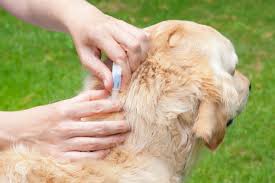 It is tick season again and one of the worst things to have to do is remove ticks from your pet after a stint outdoors. The process can be intrusive and it requires your dog to remain still, a feat in itself. Plus, once they arrive, they can cause a wide range of health problems, from skin infections to serious diseases. There are many different methods for preventing ticks and they work in different ways. Here are eight options to consider when deciding which is right for you and your pet.
It is tick season again and one of the worst things to have to do is remove ticks from your pet after a stint outdoors. The process can be intrusive and it requires your dog to remain still, a feat in itself. Plus, once they arrive, they can cause a wide range of health problems, from skin infections to serious diseases. There are many different methods for preventing ticks and they work in different ways. Here are eight options to consider when deciding which is right for you and your pet.
Topical Treatments: Over the counter topical treatments, also known as “Spot-On” treatments, are a liquid insecticide that comes in an easy to use tube applicator. They can be purchased from your veterinarian, pet store or online and can be a very effective method for controlling ticks. It is applied directly to the skin either along the back or in between the shoulder blades. Direct contact with the preventative should be avoided until the area is dry. Once applied, the treatment begins working immediately to eliminate, not only external parasites like ticks and fleas, but also internal parasites. Within 12 hours, almost all fleas and ticks that were present will be killed and the treatment will start working to get rid of all new parasites for up to one month.
applicator. They can be purchased from your veterinarian, pet store or online and can be a very effective method for controlling ticks. It is applied directly to the skin either along the back or in between the shoulder blades. Direct contact with the preventative should be avoided until the area is dry. Once applied, the treatment begins working immediately to eliminate, not only external parasites like ticks and fleas, but also internal parasites. Within 12 hours, almost all fleas and ticks that were present will be killed and the treatment will start working to get rid of all new parasites for up to one month.
Oral Medications: Oral treatments are becoming a more popular preventative option as they are very easy to apply and there is no risk to small children and cats when they come into contact with dogs immediately after application, as there may be with spot-on treatments. Oral medications help kill fleas and ticks and disrupt the life cycle of fleas. These medications come in pill, tablet, and chewable forms. Depending on the brand of oral medication, they can protect from four to 12 weeks.
Tick Collars: Tick collars release a low dose of concentrated chemicals that are meant to spread over the body through your pet’s natural oils in the hair, coat, and skin. These relatively inexpensive products are mainly only useful for protecting the neck and head from ticks. This is where the most concentrated preventative lies. The tick collar needs to make direct contact with your dog’s skin in order to transfer the chemicals to your pet. When putting this type of collar on your dog, you will need to make sure there is just enough room to fit two fingers under the collar when it’s around the dog’s neck. Cut off any excess length of collar to prevent your dog from chewing on it. Watch for signs of discomfort (e.g., excessive scratching) in case an allergic reaction to the collar occurs. When put on properly, they can help eliminate unwanted infestations of fleas and ticks within days and can provide continuous protection for up to eight months. Although you won’t have to worry about liquid products drying or giving medication to your pet, you do have to worry about children and adults coming in contact with the chemicals on the collar.
Shampoos: Bathing your dog with a shampoo that contains medicated ingredients will generally kill ticks on contact. This can be the most inexpensive, though labor intensive, method of protecting your dog during peak tick season. You will need to repeat the process about every two weeks, as the effective ingredients don’t last as long as other preventatives.
Tick Dips: A dip is a concentrated chemical that needs to be diluted in water and applied to the animal’s fur with a sponge or poured over the back. This treatment is not meant to be rinsed off after application. The chemicals used in dips can be very strong, so be sure to read the labels carefully before use. You should not use a dip for dogs under four months old or for pregnant or nursing pets.
Tick Powders: Tick powders work to kill and repel ticks from your dog. These powders should be used with care during application. Be sure that the powder you are using is labeled for dogs before use, as well as for your dog’s specific age. Also, make sure you check the label to make sure that the product is designed to kill ticks as well as fleas. This very fine powder can be an irritant to the mouth or lungs if inhaled, so use small amounts and slowly rub it into the skin. Keep powders away from the face and eyes when applying. You will need to reapply the product more often, about once a week during peak season.
Tick Sprays: Tick sprays kill ticks on contact, interrupt tick’s life cycles and can provide residual protection. Sprays are most commonly used when planning to visit outdoor and wooded areas as a convenient additional option. They can also be used in between shampoos and dips, but your pet must be dry for them to work.
House and Lawn Treatments: While the above options help prevent and protect your pet, they do not necessarily protect your home or you. Keeping your lawn, bushes, and trees trimmed back will help reduce the population of fleas and ticks in your backyard. If you still have a problem, you may need to use one of the various household and yard sprays or granular treatments that are available from your veterinarian to provide protection for your home and lawn. Just be careful when using these products, as they can be harmful to animals, fish, and humans. If you have a severe problem or you are concerned about the proper handling of these chemicals, you might want to consider hiring an exterminator to apply yard and area sprays to control the ticks and fleas.
Always speak with your veterinarian and consider all possible preventatives when making a choice for your pet. Be sure to consider your pets individual needs and possible allergies while also keeping you and your family in mind. Preventatives should never take the place of a thorough nose-to-tail exam every time your pet comes in from outside but should be used in conjuncture with.
IMPORTANT NOTE: Treatments that are perfectly suitable for dogs can be toxic to cats. Cats are particularly sensitive to
chemicals, so make sure to read all labels carefully and be absolutely certain that you are using a method of treatment designed for cats.
We’d love to hear what tick preventative you use for your dog and why you prefer this method. Share in the comments!





Leave a Reply